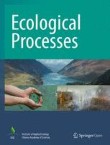Ver ítem
- xmlui.general.dspace_homeCentros Regionales y EEAsCentro Regional Patagonia SurEEA Santa CruzArtículos científicosxmlui.ArtifactBrowser.ItemViewer.trail
- Inicio
- Centros Regionales y EEAs
- Centro Regional Patagonia Sur
- EEA Santa Cruz
- Artículos científicos
- Ver ítem
Improving the knowledge of plant potential biodiversity-ecosystem services links using maps at the regional level in Southern Patagonia.
Resumen
Background: Biodiversity supports multiple ecosystem services, whereas species loss endangers the provision of many services and affects ecosystem resilience and resistance capacity. The increase of remote sensing techniques llows to estimate biodiversity and ecosystem services supply at the landscape level in areas with low available data (e.g. Southern Patagonia). This paper evaluates the potential biodiversity and how it links with ecosystem services,
[ver mas...]
Background: Biodiversity supports multiple ecosystem services, whereas species loss endangers the provision of many services and affects ecosystem resilience and resistance capacity. The increase of remote sensing techniques llows to estimate biodiversity and ecosystem services supply at the landscape level in areas with low available data (e.g. Southern Patagonia). This paper evaluates the potential biodiversity and how it links with ecosystem services, based on vascular plant species across eight ecological areas. We also evaluated the habitat plant requirements and their relation with natural gradients. A total of 977 plots were used to develop habitat suitability maps based on an environmental niche factor analysis of 15 more important indicator species for each ecological area (n = 53 species) using 40 explanatory variables. Finally, these maps were combined into a single potential biodiversity map, which
was linked with environmental variables and ecosystem services supply. For comparisons, data were extracted and compared through analyses of variance. Results: The plant habitat requirements varied greatly among the different ecological areas, and it was possible to define groups according to its specialization and marginality indexes. The potential biodiversity map allowed us to detect coldspots in the western mountains and hotspots in southern and eastern areas. Higher biodiversity was associated to higher temperatures and normalized difference vegetation index, while lower biodiversity was related to elevation and rainfall. Potential biodiversity was closely associated with supporting and provisioning ecosystem services in shrublands and grasslands in the humid steppe, while the lowest values were related to cultural ecosystem services in Nothofagus forests. Conclusions: The present study showed that plant species present remarkable differences in spatial distributions and ecological requirements, being a useful proxy for potential biodiversity modelling. Potential biodiversity values change across ecological areas allowing to identify hotspots and coldspots, a useful tool for landscape management and conservation strategies. In addition, links with ecosystem services detect potential synergies and
trade-offs, where areas with the lowest potential biodiversity are related to cultural ecosystem services (e.g. aesthetic values) and areas with the greatest potential biodiversity showed threats related to productive activities (e.g. livestock).
[Cerrar]

Autor
Rosas, Yamina Micaela;
Peri, Pablo Luis;
Lencinas, María Vanessa;
Lasagno, Romina Gisele;
Martínez Pastur, Guillermo José;
Fuente
Ecological Processes 10 : 53. (2021)
Fecha
2021-07-22
Editorial
Springer
ISSN
2192-1709 (electronic)
Formato
pdf
Tipo de documento
artículo
Palabras Claves
Derechos de acceso
Abierto
 Excepto donde se diga explicitamente, este item se publica bajo la siguiente descripción: Creative Commons Attribution-NonCommercial-ShareAlike 2.5 Unported (CC BY-NC-SA 2.5)
Excepto donde se diga explicitamente, este item se publica bajo la siguiente descripción: Creative Commons Attribution-NonCommercial-ShareAlike 2.5 Unported (CC BY-NC-SA 2.5)


